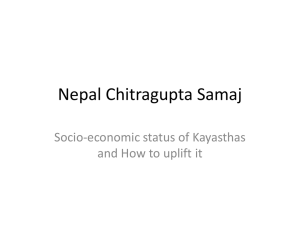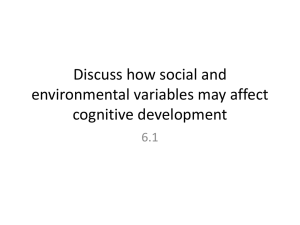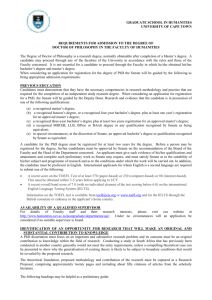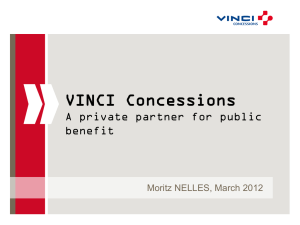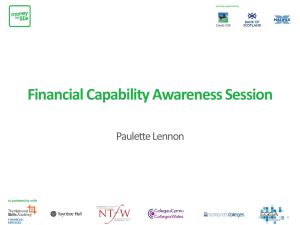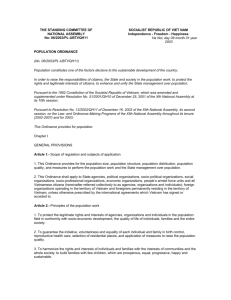Key factors for creating a successful socio
advertisement
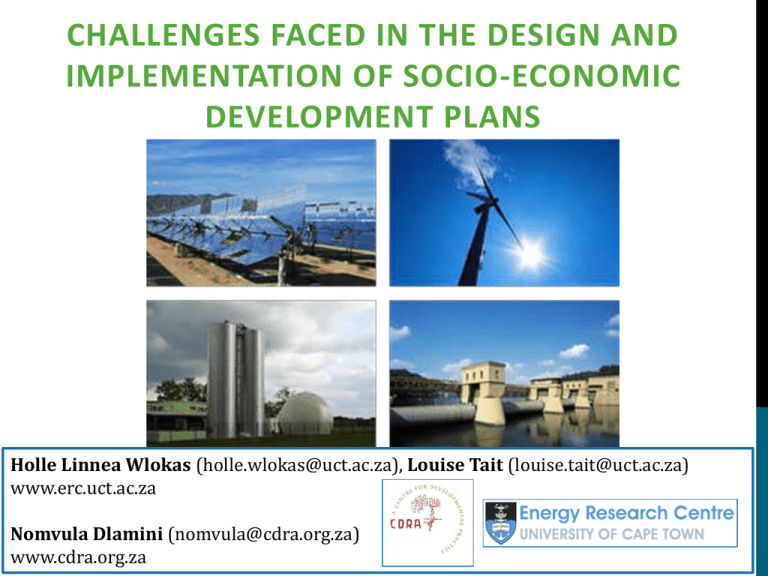
CHALLENGES FACED IN THE DESIGN AND IMPLEMENTATION OF SOCIO-ECONOMIC DEVELOPMENT PLANS Holle Linnea Wlokas (holle.wlokas@uct.ac.za), Louise Tait (louise.tait@uct.ac.za) www.erc.uct.ac.za Nomvula Dlamini (nomvula@cdra.org.za) www.cdra.org.za ENERGY, POVERTY AND DEVELOPMENT GROUP IN THE ENERGY RESEARCH CENTRE Research group • • • • Low-carbon development and poverty Poverty and mitigation (CDM, NAMA, etc.) Clean energy for low-income households Social implementation of technologies Worked alongside project developers on economic development requirements of RE IPPPP • 20 projects all over the country 2 Academic reflection & preparing future work with partner organisations like CDRA OBJECTIVE OF THE PRESENTATION Raise awareness about opportunities and challenges associated with design and implementation of SED and ED elements from a community development perspective. CONTENT 1. Review of economic development elements in RE IPPPP 3 2. Creating a successful socio-economic development programme: key consideration and factors PROJECT SELECTION 30 % 70 % Price Economic Development Source: South African Department of Energy Weighting 25% 25% 15% 5% 10% 5% 15% 100% 30 points 4 7 Economic Development Elements Job Creation Local Content Ownership Management Control Preferential Procurement Enterprise Development Socio-Economic Development Total Total points SocioEconomic Development Enterprise Development Enterprise Development • 0 - 0.6% of total revenue Job Creation Number of Citizens from Local Communities employed • 12-20% of total number of RSA Based Employees Economic Development for Local Communities Ownership Shareholding by Local Communities • 2.5- 5.0% of total shareholding • Or entire ownership requirement of 1230% 5 Socio-economic development interventions • 1 - 1.5% of total project revenue REQUIREMENTS Socio-economic development 1 to 1.5% of revenue 0 to 0.6% of revenue identify needs of surrounding communities in 50km radius provide list of enterprises earmarked for development formulate strategies on how such needs could be met give an indication of programmes that will be implemented with these enterprises 6 Economic Development Evaluation • Compliance with threshold Enterprise development UNEQUAL GEOGRAPHICAL DISTRIBUTION OF PROJECTS Geographical distribution of preferred bidders (1st and 2nd round) 7 Population 1mil THE CHALLENGES Lack of development expertise in project selection committee • Threshold is the only evaluated criteria Lack of guidelines for design and implementation of socio-economic and enterprise development Monitoring and reporting requirement focus on monetary spending 8 Unequal geographical distribution of projects REQUIRED NEXT STEPS Stimulate communication between project developers, development practitioners & academics & local government Exchange experiences and proposed strategies for socio-economic development Develop shared vision for lowcarbon community development Influence national and international policy making with these insights 9 Develop resources to support developers OPPORTUNITY AND CHALLENGE FOR DEVELOPMENT Up to developer to determine the impact of this spending! formulate strategies on how such needs could be met provide list of enterprises earmarked for development give an indication of programmes that will be implemented with these enterprises 10 identify needs of surrounding communities in 50km radius 11 IT COULD GO EITHER WAY… 12 CREATING A SUCCESSFUL SOCIO-ECONOMIC DEVELOPMENT PROGRAMME: KEY CONSIDERATION AND FACTORS COMPLEXITY OF DEVELOPMENT Pay attention to the “hardware” as well as the process - schools, clinics, vegetable gardens and small businesses are as important as where the community is in its own process of development Sustainability into the future is essential – social, economic, ecological – notion of sufficiency is important Inclusive – create a space for all to come to the table as equals; share of responsibility and rewards/benefits ENGAGEMENT WITH COMMUNITY Invest in relationship – engage through relationship Build on community assets – land, skills, knowledge, money, talents, experience, etc. Ensure ownership and commitment Clarify and manage expectations of different role players – expectations can cause conflict Establish channel of communication – clear system to allow engagement Engage with leadership and power structures CONSIDERATIONS Community is diverse – different groups and competing interests, power bases Spread the financial gains/benefits Create a formal consultative structure or mechanism A presence in the community helps (e.g. community liaison person) Integration of interventions (NDP, IDP, etc) Short-term economic benefits (important for ownership and commitment) Employment of local people and source services locally COMMUNITY TRUST Ownership and commitment Legitimate representatives Support what exists (community projects and structures for community-led development) Clear beneficiary parameters Develop capacity for administration/management of the trust Financial oversight (an ethical tone) Establish systems for monitoring, reporting and accountability THANK YOU Holle Linnea Wlokas (holle.wlokas@uct.ac.za), Louise Tait (louise.tait@uct.ac.za) www.erc.uct.ac.za Nomvula Dlamini (nomvula@cdra.org.za) www.cdra.org.za
